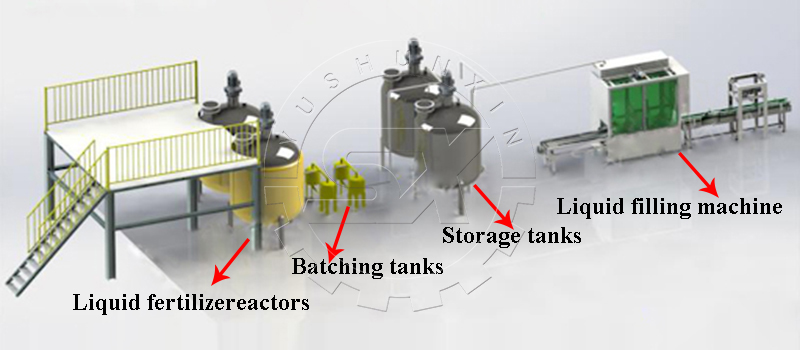Many fertilizer manufacturers want to expand into NPK liquid fertilizer production because of its fast nutrient absorption and wide market demand. To make NPK liquid fertilizer, the production process must ensure full dissolution of nutrients, accurate batching, and stable formulation. The entire process includes raw material selection, automatic dosing, reaction and mixing, additive adjustment, and product filling. Each step requires reliable equipment and proper operation to maintain consistency and efficiency.
To prepare high-quality NPK liquid fertilizer, the first step is choosing the right materials. Nitrogen sources such as urea, ammonium nitrate, or ammonium sulfate dissolve easily in water. For phosphorus, phosphoric acid or monoammonium phosphate (MAP) are common choices. Potassium usually comes from potassium chloride (KCl) or potassium sulfate (K₂SO₄). You can select fine powders to ensure fast dissolution and stable mixing. If you plan to improve trace elements, micronutrients like Fe, Zn, Mn, and B can be added through chelation or complexing.

A complete NPK liquid fertilizer production line includes:automatic batching system for ingredient dosing, reaction and mixing tanks with agitators and temperature control, auxiliary material dosing tanks for additives, filtration units to remove impurities, storage tanks and pumps for intermediate transfer, liquid filling machines for final packaging. For medium or large-scale NPK liquid fertilizer production projects, PLC automatic control and flow meters help monitor each production step, improving accuracy and efficiency.
Nhận nhà máy phân bón lỏng của bạnThe production of NPK liquid fertilizer includes five practical steps.
Automatic Batching: Đầu tiên, you should prepare the raw materials accurately by an automatic batching system. It can ensure the production of the different liquid NPK fertilizer formulations, such as 10-10-10 hoặc 20-5-10. Precision at this stage guarantees consistent nutrient concentration in the final product.
Dissolving and Reaction: Next, these raw materials enter the stainless steel reaction tank with controlled temperature and agitation. Here, chemical reactions between acids and bases take place, forming water-soluble NPK compounds. Đồng thời, proper mixing and pH adjustment prevent sedimentation and crystallization.
Auxiliary Material Addition: After NPK liquid mixing, you can add stabilizers, anti-foaming agents, or microbial additives through auxiliary dosing tanks. These components improve NPK liquid fertilizer stability, biological activity, and storage performance.
Finished Product Storage: After reaction and filtration, the solution is stored in white or stainless steel tanks. You can monitor the liquid level by direct observation or using a level gauge.
Liquid Filling and Packaging: The final product passes through a liquid fertilizer filling machine. It fills drums or bottles automatically with precise volume control. Moreover, optional labeling and capping systems help producers deliver ready-to-sell liquid NPK fertilizers.
When choosing equipment for NPK liquid fertilizer manufacturing, you should focus on material quality, professionalism of design, and after-sales service. Prefer machines made of 304 stainless steel to resist corrosion from acid and alkali materials. Ngoài ra, you should choose a reliable liquid fertilizer making machine supplier. YUSHUNXIN, as a professional liquid fertilizer plant manufacturer, provides turnkey NPK liquid fertilizer production lines from 1000 L/H to 20 T/H. Đồng thời, we offer full process design, installation guidance, and spare parts support. Chào mừng bạn đến tham khảo ý kiến!
Nhận báo giá thiết bị giải trí miễn phí và chi tiết sản phẩm, và tận hưởng các dịch vụ tùy chỉnh từng người một.
Để lại tin nhắn của bạn
 Trích dẫn
LIÊN HỆ
Trích dẫn
LIÊN HỆ
Bạn không thể sao chép nội dung của trang này